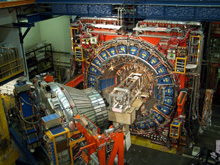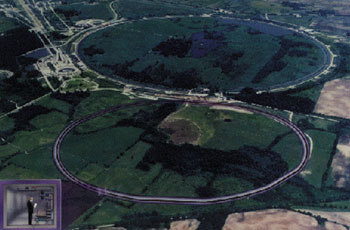

 Welcome
from the UW - Madison CDF group
Welcome
from the UW - Madison CDF group

|
About CDFCDF is a multinational experiment that studies collisions of protons and antiprotons at Fermi National Accelerator Laboratory . The CDF detector is sensitive to fundamental interactions of quarks and leptons and to a variety of possible new phenomena. CDF began operation in 1985. The detector has recently been substantially revitalized to take advantage of increased luminosity in 2000. |

Fermilab is located in Batavia, IL, about 2.5 hours south of Madison. Originally constructed around a 400 GeV proton accelerator for experiments with fixed targets, the lab now accelerates protons and antiprotons to 1 TeV in a 4 mile circumference superconducting synchrotron and operates primarily in colliding beam mode. The collisions have the highest center-of-mass energy available at any laboratory in the world at present and produce a large number of heavy and unstable elementary particles. A new antiproton production and injection system has recently been added to substantially increase the interaction rate and improve studies of rare processes. Visit Fermi National Accelerator Laboratory to take a virtual tour.
  
|
WI group activitiesThe Wisconsin CDF group has been active in the experiment since its inception. The group built and operated two forward and backward toroidal muon spectrometers to study b-quark and intermediate vector boson (W, Z) production and decay during the first Tevatron run. |
Wisconsin also constructed and installed the barrel shaped muon detectors (see BMU) for the second Tevatron run which provides forward muon identification is important analyses such as the observation of Bs - Bs oscillations, the observation of single top production, and Standard Model Higgs boson searches.
Also for the second Tevatron run Wisconsin provided a cosmic ray test stand calibration of the new electromagnetic scintillating tile/fiber endplug calorimeters.
Measurement
of the Lepton Charge Asymmetry in W-boson Decays Produced in p anti-p
Collisions (using the toroid muon system)
Published in Phys.Rev.Lett.81, 5754-5759, 1998.
Observation of Bs - Bs oscillations (using the BMU system)
Published in Phys.Rev.Lett. 97. 242003, 2006.
Search for a Higgs Boson Decaying to Two W Bosons at CDF
Published in Phys.Rev.Lett. 102. 021802, 2009.
The CDF group provides research appointments to students of particle physics who participate in detector operation and data analysis. Interested students should contact either Professors Carlsmith, Herndon, or Pondrom. CDF WI thesis's include:
Search for a Neutral Higgs Boson Decaying to a W Boson Pair in ppbar Collisions at sqrt{s} = 1.96 TeV
Published in Phys.Rev.Lett. 97, 081802, 2006.
Measurement of b anti-b rapidity correlations in p anti-p collisions at s1/2=1.8 TeV.
Published in Phys. Rev. D. 61, 032001, 2001.
Observation of W+ W- production in anti-p p collisions at s1/2 = 1.8-TeV.
Published in Phys.Rev.Lett. 78, 4536-4540, 1997.
A database of CDF theses is available. General information about graduate study in particle physics at the University of Wisconsin-Madison may be found at the following links:
CDF publications describe:

|
Latest CDF Physics News! Mar 13 2009: Fermilab experiments constrain Higgs mass.
|